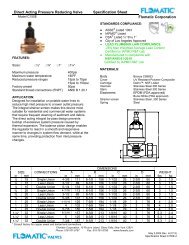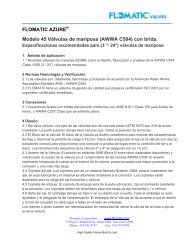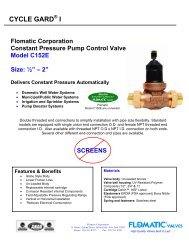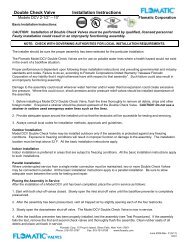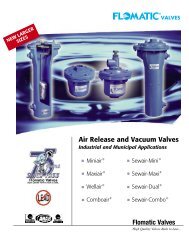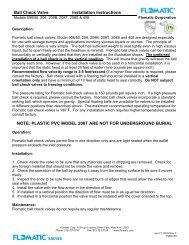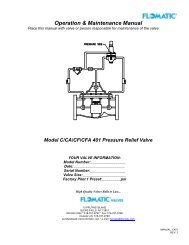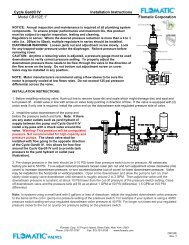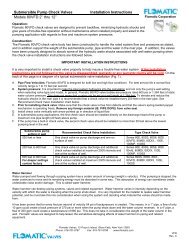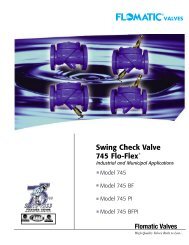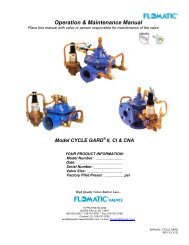Unleaded Backflow Preventers Flomatic Valves - Flomatic Corporation
Unleaded Backflow Preventers Flomatic Valves - Flomatic Corporation
Unleaded Backflow Preventers Flomatic Valves - Flomatic Corporation
You also want an ePaper? Increase the reach of your titles
YUMPU automatically turns print PDFs into web optimized ePapers that Google loves.
BACKFLOW PREVENTERS–RPZEWORKING PRINCIPLE<strong>Flomatic</strong>’s RPZE devices (reduced pressure principle backflow preventer) provide maximum protection against backsiphonageand backpressure. This superior safeguard technology consists of two independently acting check valves anda relief valve. <strong>Flomatic</strong> has recognized the need for unleaded backflow preventers which will assure safe drinking water.We are committed to a clean environment and to providing the most reliable valves in the industry.1.2.Flow DirectionNORMAL FLOW CONDITIONS1) In this illustration, water flows in a normal direction withan inlet pressure of 100 PSI. The inlet pressure flows throughan internal port to the top side of the relief valve diaphragm.The pressure drop across the first check valve into the“zone” area is approximately 6 PSI. The relief valve is held inthe closed position due to the higher pressure on the top ofthe diaphragm. The second check valve operates with a lighterspring load, this creates the double check valve advantage, andfurther reduces the pressure by 1 PSI to 93 PSI or less.STATIC PRESSURE CONDITION2) In this no flow condition, upstream water pressure is 100 PSI,while the pressure in the “zone” (between the two checkvalves) is approximately 94 PSI. The 6 PSI differential ensuresthat the relief valve remains closed. If the first check valve leaksduring this condition, the high water pressure will leak into the“zone” and cause the relief valve to open. This condition wouldresult in a visual leakage at the relief valve vent.3b.4.BACK-PRESSURE CONDITION3) In this illustration, the downstream pressure increases to 110PSI and causes a backflow condition.a) The second check valve will normally prevent the higherpressure from entering the “zone” between the checkvalves. The relief valve will remain closed since 6 PSI differentialpressure is being maintained between the supply pressureand the zone.b) If the second check valve is obstructed or fouled,the water will leak into the center chamber and increase thepressure. As the pressure increases to approximately97 PSI the relief valve starts to open, dumping the potentiallycontaminated liquid into the waste drain.LEGENDLight Inlet PressureLight Outlet PressureLight Intermediate Zone PressureBACK-SIPHONAGE CONDITION4) In this illustration, the supply pressure drops causing areduction of pressure on the top of the relief valve diaphragm.When the differential pressure between the supply and “zone”is decreased to 3 PSI, the relief valve will start to open. Shouldthe inlet pressure drop to atmosphere or below, the relief valvewill be fully open and the water between the two check valves(zone) will discharge.®2



